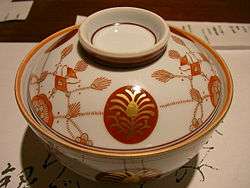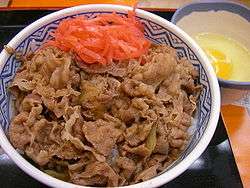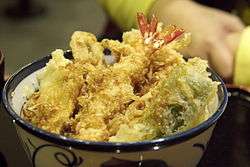Definify.com
Definition 2025
丼
丼
| ||||||
|---|---|---|---|---|---|---|
Translingual
Han character
丼 (radical 3 丶+4, 5 strokes, cangjie input 廿廿戈 (TTI), four-corner 55000, composition ⿴井丶)
References
- KangXi: page 81, character 1
- Dai Kanwa Jiten: character 101
- Dae Jaweon: page 164, character 1
- Hanyu Da Zidian: volume 1, page 45, character 1
- Unihan data for U+4E3C
Chinese
Etymology 1
|
simp. and trad. |
丼 | |
|---|---|---|
Pronunciation
- Mandarin
- (Standard Chinese, Beijing)+
- Pinyin:
- Zhuyin: ㄉㄢˇ
- Wade-Giles: tan3
- Gwoyeu Romatzyh: daan
- IPA (key): /ta̠n²¹⁴/
- (Standard Chinese, Beijing)+
- Cantonese
- (Standard Cantonese, Guangzhou)+
- Jyutping: dam2
- Yale: dám
- Cantonese Pinyin: dam2
- IPA (key): /tɐm³⁵/
- (Standard Cantonese, Guangzhou)+
- Min Nan
- (Hokkien)
- Pe̍h-ōe-jī: tôm
- Tâi-lô: tôm
- Phofsit Daibuun: doom
- IPA (Xiamen): /tɔm²⁴/
- IPA (Quanzhou): /tɔm²⁴/
- IPA (Zhangzhou): /tɔm¹³/
- IPA (Taipei): /tɔm²⁴/
- IPA (Kaohsiung): /tɔm²³/
- (Hokkien)
| Rime | |
|---|---|
| Character | 丼 |
| Reading # | 1/1 |
| Initial (聲) | 端 (5) |
| Final (韻) | 覃 (159) |
| Tone (調) | Rising (X) |
| Openness (開合) | Open |
| Division (等) | I |
| Fanqie | 都感切 |
| Reconstructions | |
| Zhengzhang Shangfang |
/tʌmX/ |
| Pan Wuyun |
/təmX/ |
| Shao Rongfen |
/tɒmX/ |
| Edwin Pulleyblank |
/təmX/ |
| Li Rong |
/tᴀmX/ |
| Wang Li |
/tɒmX/ |
| Bernard Karlgren |
/tămX/ |
| Expected Mandarin Reflex |
dǎn |
| Zhengzhang system (2003) | |
|---|---|
| Character | 丼 |
| Reading # | 1/2 |
| No. | 2041 |
| Phonetic component |
丼 |
| Rime group |
談 |
| Rime subdivision |
3 |
| Corresponding MC rime |
黕 |
| Old Chinese |
/*kloːmʔ/ |
| Notes | 集韻又義與𣿅合,吳方言作澸今字 |
Noun
丼
Etymology 2
| For pronunciation and definitions of 丼 – see 井. (This character, 丼, is a variant form of 井.) |
References
- ↑ 《集韻》:「丼:投物井中聲。」
Japanese
Kanji
Readings
Etymology 1
| Kanji in this term |
|---|
| 丼 |
|
どんぶり Grade: S |
| kun'yomi |
Multiple possible derivations.
- During the Edo period, restaurants specializing in large portions were called 慳貪屋 (kendon'ya), from 慳貪 (kendon, “greedy”, in reference to “very hungry”) + 屋 (ya, “house, store, restaurant”). The serving bowls were called 慳貪振り鉢 (kendon-buri-bachi), literally “greedy” + “in that fashion” + “bowl”. The ken portion was elided, producing donburi-bachi, and then the -hachi was dropped to produce donburi.
- Alternatively, and perhaps more likely, donburi in reference to “a bowl filled with large amount of food” may be cognate with どんぶり (donburi), an onomatopoeia of something heavy plunking into deep water, or something big and soft plopping down, related to onomatopoeia どぶり (doburi), どぶん (dobun), どんぶ (donbu), and どん (don), all of generally similar meanings. The food starts with a large portion of rice, also referred to as 丼飯 (donburi meshi), which could be analyzed as “plopped-down rice”.
- Donburi is also used to refer to something “rough, approximate, not finely worked”, as in the phrase 丼勘定 (donburi kanjō, “rough approximation, loose estimate”). This is consistent with a derivation from the onomatopoeia, but not from the restaurant terms.
The kanji spelling shows 井 (“a well”) with a dot in the center, possibly indicating something thrown into the well. This could suggest that the Middle Chinese reading /təmX/ may similarly derive from onomatopoeia.
Pronunciation
Noun
丼 (hiragana どんぶり, romaji donburi)
- a simple large bowl for serving food
- a one-bowl meal served in a donburi bowl, consisting of a large portion of rice, covered in a meat or fish
Usage notes
To disambiguate, speakers may refer more specifically to donburibachi for the bowl, and donburi mono for the food.
English-language sources often refer to the food as similar to stew served over rice. Note, however, that stews consist of meat, fish, and/or vegetables cooked in a liquid and served with the sauce, whereas donburi toppings may be relatively dry, as in tempura donburi or beef donburi, or even uncooked, as in tekkadon (tuna sashimi donburi).
Synonyms
Derived terms
Etymology 2
| Kanji in this term |
|---|
| 丼 |
|
どん Grade: S |
| kun'yomi |
Abbreviation of donburi above.[2][1]
Pronunciation
- Kun'yomi
- (Tokyo) どん [dóꜜǹ] (Atamadaka - [1])[1]
- IPA(key): [dõ̞ɴ]
- When used as a suffix, the resulting term has a 平板型 (heiban-gata, “flat type”) or type 0 pitch accent pattern.
Noun
Usage notes
Seldom used as an independent noun. More commonly encountered as a suffix.
Suffix
丼 (hiragana どん, romaji -don)
Derived terms
|
References
- 1 2 3 2006, 大辞林 (Daijirin), Third Edition (in Japanese), Tōkyō: Sanseidō, ISBN 4-385-13905-9
- ↑ 1988, 国語大辞典(新装版) (Kokugo Dai Jiten, Revised Edition) (in Japanese), Tōkyō: Shogakukan
Korean
Hanja
丼 • (jeong) (hangeul 정, McCune-Reischauer chŏng)
- This term needs a translation to English. Please help out and add a translation, then remove the text
{{rfdef}}.



